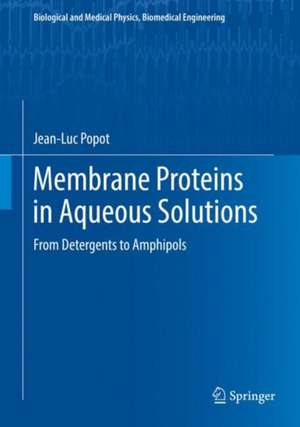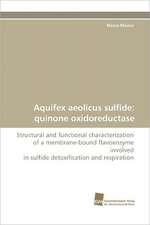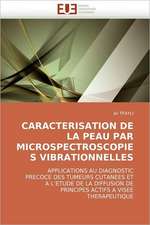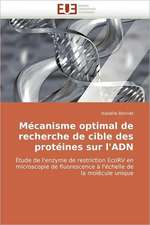Membrane Proteins in Aqueous Solutions: From Detergents to Amphipols: Biological and Medical Physics, Biomedical Engineering
Autor Jean-Luc Popoten Limba Engleză Hardback – 21 iun 2018
Important features of the book include introductory sections describing foundations as well as the state-of-the-art for each of the biophysical techniques discussed, and topical tables which organize a widely dispersed literature. Boxes and annexes throughout the book explain technical aspects, and twelve detailed experimental protocols, ranging from in vitro folding of membrane proteins to single-particle electron cryomicroscopy, have been contributed by and commented on by experienced users.
Membrane Proteins in Aqueous Solutions offers a concise, accessible introduction to membrane protein biochemistry and biophysics, as well as comprehensive coverage of the properties and uses of conventional and non-conventional surfactants. It will be useful both in basic and applied research laboratories and as a teaching aid for students, instructors, researchers, and professionals within the field.
| Toate formatele și edițiile | Preț | Express |
|---|---|---|
| Paperback (1) | 1028.15 lei 43-57 zile | |
| Springer International Publishing – feb 2019 | 1028.15 lei 43-57 zile | |
| Hardback (1) | 1417.23 lei 43-57 zile | |
| Springer International Publishing – 21 iun 2018 | 1417.23 lei 43-57 zile |
Din seria Biological and Medical Physics, Biomedical Engineering
- 5%
 Preț: 1110.32 lei
Preț: 1110.32 lei - 18%
 Preț: 1006.55 lei
Preț: 1006.55 lei - 18%
 Preț: 960.78 lei
Preț: 960.78 lei - 18%
 Preț: 704.11 lei
Preț: 704.11 lei - 18%
 Preț: 967.40 lei
Preț: 967.40 lei - 18%
 Preț: 948.92 lei
Preț: 948.92 lei - 15%
 Preț: 641.71 lei
Preț: 641.71 lei - 15%
 Preț: 644.95 lei
Preț: 644.95 lei - 15%
 Preț: 665.08 lei
Preț: 665.08 lei - 18%
 Preț: 1669.16 lei
Preț: 1669.16 lei - 18%
 Preț: 941.05 lei
Preț: 941.05 lei - 18%
 Preț: 956.81 lei
Preț: 956.81 lei - 18%
 Preț: 950.21 lei
Preț: 950.21 lei - 15%
 Preț: 636.80 lei
Preț: 636.80 lei - 18%
 Preț: 947.50 lei
Preț: 947.50 lei - 15%
 Preț: 636.80 lei
Preț: 636.80 lei -
 Preț: 397.01 lei
Preț: 397.01 lei - 18%
 Preț: 1236.99 lei
Preț: 1236.99 lei - 15%
 Preț: 644.49 lei
Preț: 644.49 lei - 18%
 Preț: 946.55 lei
Preț: 946.55 lei - 15%
 Preț: 712.22 lei
Preț: 712.22 lei - 18%
 Preț: 952.89 lei
Preț: 952.89 lei - 18%
 Preț: 944.36 lei
Preț: 944.36 lei - 18%
 Preț: 1228.29 lei
Preț: 1228.29 lei - 5%
 Preț: 1422.67 lei
Preț: 1422.67 lei - 18%
 Preț: 1393.27 lei
Preț: 1393.27 lei - 15%
 Preț: 651.19 lei
Preț: 651.19 lei - 18%
 Preț: 953.65 lei
Preț: 953.65 lei - 18%
 Preț: 955.88 lei
Preț: 955.88 lei - 15%
 Preț: 644.95 lei
Preț: 644.95 lei - 5%
 Preț: 1098.48 lei
Preț: 1098.48 lei - 18%
 Preț: 959.19 lei
Preț: 959.19 lei - 15%
 Preț: 643.65 lei
Preț: 643.65 lei - 5%
 Preț: 1159.16 lei
Preț: 1159.16 lei - 5%
 Preț: 1102.67 lei
Preț: 1102.67 lei - 18%
 Preț: 952.09 lei
Preț: 952.09 lei - 18%
 Preț: 946.55 lei
Preț: 946.55 lei - 18%
 Preț: 952.09 lei
Preț: 952.09 lei - 15%
 Preț: 703.20 lei
Preț: 703.20 lei - 18%
 Preț: 953.65 lei
Preț: 953.65 lei - 5%
 Preț: 1008.45 lei
Preț: 1008.45 lei - 15%
 Preț: 644.82 lei
Preț: 644.82 lei - 18%
 Preț: 956.03 lei
Preț: 956.03 lei - 15%
 Preț: 647.40 lei
Preț: 647.40 lei
Preț: 1417.23 lei
Preț vechi: 1728.33 lei
-18% Nou
Puncte Express: 2126
Preț estimativ în valută:
271.27€ • 294.76$ • 228.02£
271.27€ • 294.76$ • 228.02£
Carte tipărită la comandă
Livrare economică 21 aprilie-05 mai
Preluare comenzi: 021 569.72.76
Specificații
ISBN-13: 9783319731469
ISBN-10: 3319731467
Pagini: 765
Ilustrații: XXVII, 708 p. 437 illus., 266 illus. in color.
Dimensiuni: 178 x 254 mm
Greutate: 1.48 kg
Ediția:1st ed. 2018
Editura: Springer International Publishing
Colecția Springer
Seria Biological and Medical Physics, Biomedical Engineering
Locul publicării:Cham, Switzerland
ISBN-10: 3319731467
Pagini: 765
Ilustrații: XXVII, 708 p. 437 illus., 266 illus. in color.
Dimensiuni: 178 x 254 mm
Greutate: 1.48 kg
Ediția:1st ed. 2018
Editura: Springer International Publishing
Colecția Springer
Seria Biological and Medical Physics, Biomedical Engineering
Locul publicării:Cham, Switzerland
Cuprins
From the Contents: Membrane proteins: functions, structures, environments.- Taking membrane proteins out of their natural environment.- Alternatives to detergents for handling membrane proteins in aqueous solutions.- Chemical structure and physical-chemical properties of amphipols.
Notă biografică
Jean-Luc Popot, born 1948, studied biology, chemistry, and biophysics in Orléans and Orsay. In 1971, he took a permanent position with the Collège de France. In J.‑P. Changeux’s laboratory, at the Pasteur Institute, he applied electrophysiology and biophysical and biochemical approaches to functional and structural studies of the nicotinic acetylcholine receptor. In 1982, he joined D.M. Engelman at Yale University as a visiting scientist. His work at Yale, which bore principally on refolding bacteriorhodopsin from denatured fragments and studying the refolded structure crystallographically, led the two of them to propose, in 1990, an influential model for the folding of α‑helical membrane proteins. In 1985, he joined the laboratory of P. Joliot at the Institut de Biologie Physico-Chimique (Paris). His group carried out neutron diffraction and model building work on bacteriorhodopsin and biochemical studies on Photosystem II and cytochrome b6 f. In 1996, he became Research Director at the Centre National de la Recherche Scientifique and created his own laboratory, where the X‑ray structure of the b6 f was solved in 2003. In parallel, he pursued the development of sequence analysis approaches and, in collaboration with chemists and physical chemists, designed and validated non-conventional surfactants aimed at facilitating membrane protein solution studies, most notably amphipathic polymers (‘amphipols’) and fluorinated surfactants. He retired in 2013 and, along with his wife, splits his time between restoring an old house in Languedoc, reading, writing, hiking, photographing, cooking, and enjoying the company of kith and kin.
Textul de pe ultima copertă
Membrane proteins represent about one third of the proteins encoded in a cell's genome, and, because of their key physiological roles, more than half of drug targets. Detergents are traditionally used to extract proteins from membranes in order to make them amenable to the tools of biochemistry and biophysics. However, detergent-solubilized proteins are generally unstable. This has led to the development of alternative, non-conventional surfactants, such as bicelles, nanodiscs, amphipathic peptides, fluorinated surfactants, and specially designed amphipathic polymers called 'amphipols'. These novel tools, mainly developed over the past 20 years, are revolutionizing handling membrane proteins in vitro for basic and applied research, as well as for such biomedical applications as drug screening or vaccination.
This book, written by a specialist of membrane proteins and one of the creators of amphipols, describes the properties and usesof these novel molecules. It opens with general introductions on membrane proteins and their natural environment, detergents, the current status of membrane protein in vitro studies, a broad panorama of non-conventional surfactants and a discussion of their respective advantages and limitations, and the preparation and properties of amphipols and membrane protein/amphipol complexes. Topical chapters cover in vitro folding, cell-free synthesis and stabilization of membrane proteins, and such biophysical and biochemical applications as electron microscopy, Xray diffraction, NMR, optical spectroscopy, mass spectrometry, the whole range of solutions studies, proteomics, and such practical applications as membrane protein immobilization and drug screening and the use of amphipols in vivo for vaccination and drug delivery. Each topical chapter is introduced with a concise, up-to-date overview of how membrane proteins are currently studied using each individual technique, before offering an exhaustive coverage and in-depth discussion of the contribution of amphipols, and concluding with hands-on protocols written by everyday practitioners of each application.
In addition to a comprehensive coverage of the properties and uses of non-conventional surfactants, this book therefore also offers a concise, accessible introduction to membrane protein biochemistry and biophysics. It is meant to be used both in basic and applied research laboratories and as a teaching help.
Caracteristici
First book dedicated to the art of handling membrane proteins in aqueous solutions Includes a Foreword by Donald M. Engelman and over 30 cartoons created by Francis Haraux Includes over 400 richly illustrated figures and topical tables as well as twelve detailed, experimental protocols






















